Retaining Wall with Efflorescence: White Chalky Powdery Look & When A Concern
Home » Yard, drive, walks, patios » Retaining walls »
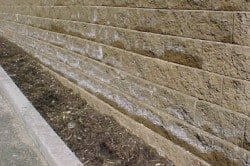
If a retaining wall is constructed from masonry block, brick or concrete, and has a white powdery or chalky looking substance on it, then it’s probably efflorescence. This is usually a sign that moisture is slowly migrating through the wall.
Generally efflorescence is looked upon as cosmetic in nature; however, it may be a warning sign that there is a structural issue or that some form of preventive maintenance is needed. As a homeowner or buyer there a few things that you should look into when efflorescence is observed on a retaining wall.
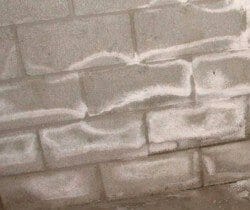
Check the following:
- Does the soil behind the wall appear overly wet or soaked. Depending on the type of soil; wet or soaked soil may weigh 10% to 50% more than dry soil.
- Cracks. Are there cracks in the retaining wall? Hairline cracks or ones that are1/4 to 3/8 inch or larger?
- Leaning. Is the wall leaning or does it look like the wall is about to topple over?
- Bowed. Sight down the wall to see if it is wavy or bowing outward; use a string line if you’re not sure.
- Rust stains. Are there rust stains leaking through cracks in the wall? Lots or little?
- Spalling. Are there sections of the masonry wall that are cracking or breaking off?
- Is there deterioration of the masonry block, brick or concrete. Negligible or significant?
One concern from a structural point is that if there is steel reinforcement (usually called rebar) in a retaining wall and if it starts to rust, it may expand. Over a long period of time the rusting rebar may expand up to four times its diameter and this causes cracks, spalling and weakens the wall.
If any of the above conditions exist
Should one or more of the above conditions be observed, then you may want to think about the following before making any decisions; the height of the wall, the location of wall, and how much pressure is there against the wall.
Is the retaining wall low, medium or high?
The reason this may be important is that the higher the wall, the more potential of damage occurring. A retaining wall that is only three or four feet high and 10 or 15 feet from the house does not present nearly the risk as one that is 12 foot high and 8 feet from the home; all other things being equal.
Basically if the retaining wall should fail, would the home incur damage and if so, how much damage.
A home that is located where there are two or more retaining walls, i.e. one located on a hillside with a retaining wall on the uphill side and one on the downhill side, then each wall may cause damage to a house, but in different ways.
The wall on the uphill side
If the retaining wall is on the uphill side of the home and the wall fails, will the wall fall against the house itself or will the soil behind the wall hit the house? The closer and higher the wall; the higher the level of a concern.
The wall on the downhill side
Problems with this wall may cause the soils supporting the foundation to drop down. When the foundation drops down, the rest of the structure sitting on top of that portion of foundation drops down. This can result in significant damage, depending on how much the soil drops or sinks.
When a foundation moves, it may damage the foundation itself or crack a concrete slab; it can also crack or damage underground gas lines, sewer lines and water lines.
Is the soil behind the wall flat or is it sloped uphill
This affects the amount of pressure against the wall. All other things being equal, a wall that is holding back a sloped hillside will have more pressure against it than a wall holding back the soil of a flat lot next to it
Does the retaining wall have weep holes or a French drain behind it?
When contractors build retaining walls, they usually provide a way or path for excess water in the soil to drain out. If water gets trapped in the soil behind a retaining wall there are several things that may happen:
- The soil when wet weighs a lot more than dry soil, thus the wet soil is exerting much more weight or pressure against the wall
- In wet or soaked soil, the soil particles do not adhere to one another very well and because of this the hillside tends to slide or shift downward putting more pressure on the wall. An extreme example would be when a hillside is so wet, that it becomes a mudslide.
These two conditions may cause a retaining wall to topple or fail.
Weep hoes and French drains
Weep holes
To prevent moisture from building up behind a retaining wall contractors often leave the mortar out of the vertical joints on the bottom row of block (usually every other block). This provides a gap about 3/8 inch wide and 8 inches high, which allows water behind the block to drain out. If the wall is solid concrete, they may place a hole in the bottom area of the wall, about 1 inch in diameter, in order for moisture to drain out. These holes are usually 12 to 32 inches apart.
French drain
Another way contractors prevent water from building up is to install a French drain behind the wall. There are various types of French drains, but in general they’re a 3 to 4 inch diameter pipe with perforated holes to allow water to enter the pipe. The pipe may be partially covered with gravel and a porous fabric over it that allows moisture to easily drain through it into the pipe but keeps the dirt from clogging the holes and pipe. This pipe then drains to the street or some other location on the property.
Note that it can be very difficult at times to tell if there is a French drain, for it is usually covered by dirt if there is one. At times if you have a copy of the building plans you can tell, or the local building jurisdiction may also have a set of plans and if the builder is still around, he may know.
No weep holes or French drain
There are some retaining walls that do not have a method for draining water from behind them and this can present a problem, especially if there is lot moisture that builds up.
Preventive maintenance
There are a number of things an owner can do to help handle moisture issues with retaining walls. Choosing which ones depends on what the specific issues are with the wall. Some of the options may be:
- Add weep holes
- Add a French drain
- Control moisture entering soil that the retaining wall is holding back
- Control any hillside sprinklers so they do not over water
- Maintain vegetation on the hillside. It also helps reduce erosion
- Have a rodent control program. Gopher and ground squirrel holes allow more water to saturate a hillside and thus can de-stabilize the hillside.
- Emergency type actions to help control moisture; cover hillside with visqueen or plastic.
Walls that have efflorescence on them may have some deterioration on the face of the walls if the moisture migration has been taking place over a long period of time. Normally this deterioration is very limited in nature and not very deep, however, preventative measures should still be taken. A second reason for reducing the moisture migrating through the wall is that there is steel rebar in the wall, and when it comes into contact with moisture, it may begin to rust.
This may sound silly
If there is a swimming pool located on a hillside above your retaining wall and there is a leak in the pool or its piping, then the leak may cause damage to your retaining wall. This rarely happens but it does happen, the author has seen it twice.
Who to Ask
Should you have concerns about a retaining wall there are a number of professionals that you may wish to consult with. Be sure that they are personally appropriately qualified to answer your questions. They may include|
- Geotechnical engineers
- Structural engineers
- Qualified retaining wall contractors
- Local Building Department

Bottom Line
As mentioned at the beginning, efflorescence is general not much of a concern but in a few instances may be a warning sign of moisture issues. A retaining wall that is slightly cracked, leaning or damaged and only has limited efflorescence will generally be one of of little concern. Often when there are moisture issues a few preventive measures would be wise.
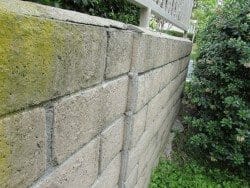
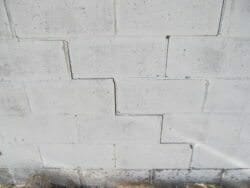
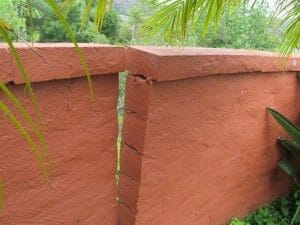
Hello-
I recently had a retaining wall installed in my backyard. It holds up a small hill, so water flows through the soil and into the back of the retaining wall. A french drain was included, but I noticed recently that the bottom row (Belgard block) is saturated with water. I’m wondering if this is normal and the block can withstand being moist on an almost indefinite basis, or if this poses a problem. I haven’t had much luck finding information on this so any response would be appreciated.
Thank you, Greg